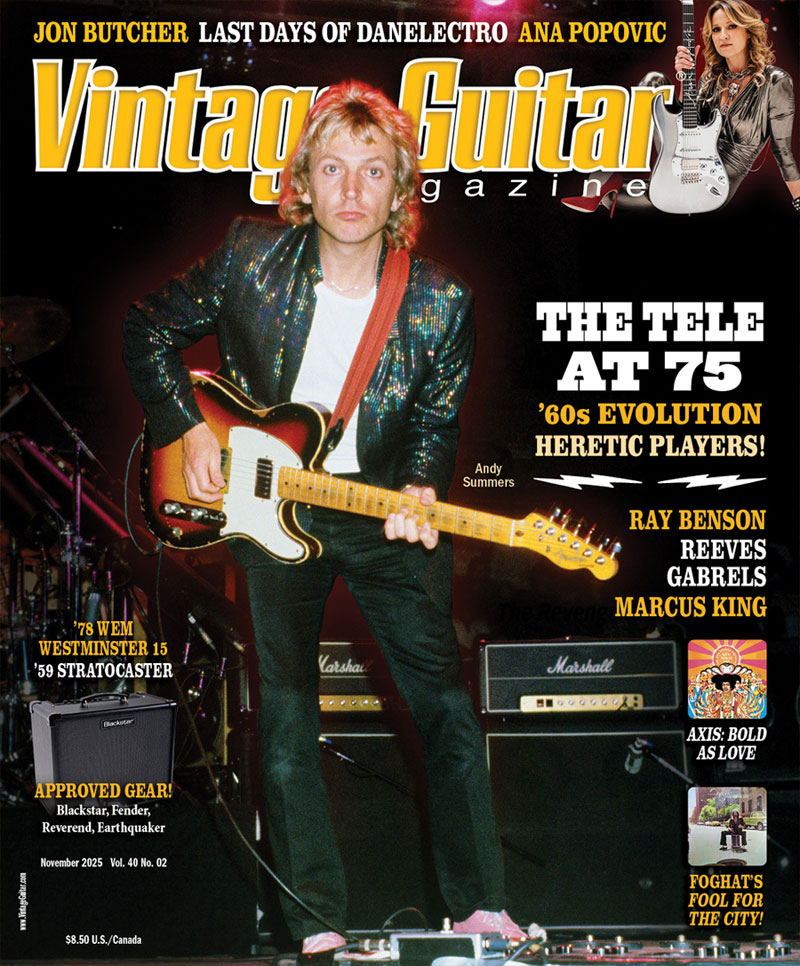
Throughout his career, Gary Moore was haunted by a prevailing assumption (in rock circles) that he was simply too good to gain mass popularity. An accomplished, soulful vocalist and genuine guitarist’s guitarist, his versatility and technical mastery enabled him to move effortlessly from blues, rock, and power pop to metal, techno, hard rock, fusion, and Celtic, all while maintaining an uncompromising musical personality.
Largely ignored by critics and woefully unknown to the average listener, Moore changed his trajectory after two decades in hard rock and reemerged as the consummate blues-rock champion on his eighth solo studio album, 1990’s Still Got the Blues.
The timing was ideal, as his style resonated with the public after a decade that saw the rise of Stevie Ray Vaughan and Jeff Healey, the return of Robben Ford, and a renewed appetite for guitar-centric blues.
Still Got the Blues is a defining document. Moore and co-producer/engineer Ian Taylor gathered a who’s-who of British rock luminaries and session players: keyboardists Don Airey (Ozzy Osbourne, Deep Purple), Nicky Hopkins (Jeff Beck, Stones), Mick Weaver (Traffic, David Gilmour), bassists Bob Daisley (Ozzy, Black Sabbath), Andy Pyle (Blodwyn Pig, Savoy Brown, Wishbone Ash), and drummers Brian Downey (Thin Lizzy) and Graham Walker. Horns adorned numerous tracks with trumpeters Stuart Brooks, Raul D’Oliveira, and Martin Drover, as well as saxophonists Frank Mead, Nick Payn, and Nick Pentelow. A string section led by Gavyn Wright complemented several arrangements. On guitar, Moore was joined by Albert King, Albert Collins, and George Harrison.
Tactically, he prized spontaneity, freedom, and humanity during the sessions. Despite the impression of a carefully crafted work, the album was largely recorded live with no overdubbing and “mistakes left in” (see if you can find ’em).

From Moore’s second solo in “Oh Pretty Woman,” this lick illustrates his command and the way he modernized blues idioms. His minor-pentatonic and traditional blues scales and string bending are at the forefront, particularly potent in the major-third bend into the ninth tone in measure 8. Also noteworthy is the virtuosic double-timing in 3-4, 6, and 8-9. These flourishes are endemic to the shredder side of his persona and allude to his playing in hard rock and metal, which are highly effective into a blues setting.
Recording took six weeks. Favoring the classic British blues-rock sound, Moore eschewed rackmount effects and superstrats and chose the reliable and definitive Les Paul-into-Marshall combination. He used a newly acquired ’59 Standard (dubbed “Stripe,” it bore serial number 9 2227 and was thought to be Ronnie Montrose’s long-lost guitar) that soon became his main guitar, along with Peter Green’s ’59 Standard, “Greeny,” which Moore had owned since 1970. Both had original PAF pickups. Strat timbre is heard on “Texas Strut,” likely the same ’61 Fiesta Red model he played at Montreux in ’90. He plugged into an early reissue Marshall JTM45 head with 5881 tubes feeding a 1960B 4×12 stack containing Electro-Voice speakers. Additional saturation and sustain came via a Marshall Guv’nor overdrive pedal simulating JCM800 gain. Onstage, he often relied on Soldano SLO-100 heads (with Guv’nor or Ibanez Tube Screamer TS10 on the Clean+Crunch channel). He preferred Dean Markley 2504B (.010-.052) string sets and extra-heavy (1.14mm 351 shape) celluloid picks.
The program featured five Moore originals presenting facets of his eclectic blues vision, six standards, and a surprise contribution from Harrison. The results were inescapable. Released March 12, Still Got the Blues reached #83 on Billboard the following February and garnered Gold by November ’95. It remains Moore’s most successful album, having reset his journey as a reinvented blues-rock hero in the age of grunge, alternative, and nu-metal.
The opening track, “Moving On,” is an artistic metaphor marking his departure from ’80s pop-metal and commercial hard rock. A straightforward “road” travelogue cruising atop a groove-driven/riff-based arrangement backed by Weaver, Pyle, Walker, it’s laden with Open A slide licks (which Moore played standard-tuned in live performances) reminiscent of Joe Walsh, Billy Gibbons, and Duane Allman. These attributes convey a simpler country-inflected blues-rock feeling, recall his slide playing with Thin Lizzy, and set the stage for the album’s proceedings.
“Oh Pretty Woman” is a towering blues classic elevated by the participation of the legendary Albert King. Ostensibly recalling Mayall’s Bluesbreakers ’67 version (featuring Mick Taylor) with its four-piece horn section and Airey’s B3, it’s heavier and more aggressive, pitting Moore’s saturated tone against King’s cleaner, brighter twang. Moore feels his way through two ferocious white-knuckle solos offset by King’s laidback chorus, then ends the tune with a virtuosic cadenza reminiscent of his fusion episodes in Colosseum II. The album’s first single, it was released March 5.
“Walking By Myself” updates Jimmy Rogers’ early-’50s Chicago blues. Weaver on piano and Frank Mead on harmonica sweeten the flavor, alluding to Otis Spann and Little Walter while Moore adds rock swagger and distortion to the mid-tempo shuffle. Notable are ’80s tapping and quick technical flurries in his solo alongside a paraphrase of “Dust My Broom” mixing modern power rock with traditionally laid-back blues. It was released as the third single on August 6.

“Still Got the Blues” demonstrates the range of Moore’s style. Assuming a very melodic character, he’s explicit in the vocalesque phrasing and thoughtful note selection, highlighting sophisticated harmonic sounds inherent in the cycling chord changes. Note the emphasis of sweet major-seventh tones – B and E over C major and F major in measures 4-5 and 12-13 from hexatonic sources and inclusion of G# and F over E7 in 7. These phrases convey a jazz-informed, sax-like sensibility while his pentatonic blues melody (as in the specific minor pentatonic lines in 14 over Bm7b5) and idiomatic string bends are solidly steeped in blues-guitar tradition.
“Still Got the Blues,” a masterpiece of sophistication and soul, embodied Moore’s aspirations and tangents reexamined through the blues prism. The culmination of his nuanced melodic stye heard earlier in “Parisienne Walkways” and other pieces, the title track proved he could imbue any harmonic pattern (here the same well-used minor cycle-of-fifths progression heard in “Autumn Leaves” or “I Will Survive”) with his emotional blues feeling and singing sustaining lines, much in the way Santana did in “Europa.” The arrangement was complemented by Wright’s lush string orchestration, Hopkins’ piano, and Airey’s keyboards. Gary’s harmonically astute rock sensibilities were glimpsed in “Still in Love With You,” “Empty Rooms,” and “The Loner,” but reached a zenith in “Still Got the Blues” – reconciling his jazz acumen with rock attitude while reaffirming claim to an uncharted sector of the blues-rock universe. The album’s second single, it was released April 30, and was Moore’s only single to make the U.S. charts (#97).
“Texas Strut” brings allusions to ZZ Top-fueled boogie including “how-how” field-holler quotes and a reworked turnaround straight out of “La Grange,” along with SRV-inspired singing and overdriven-Strat sound. The mood is raw, loose, and serves as perfect contrast to the previous track’s complexity.
“Too Tired,” by Johnny “Guitar” Watson, is one of the genre’s lesser-known (but indispensable) pieces, here given a powerful treatment with punchy horn-section accents reminiscent of Watson’s ’55 recording, Airey’s piano, and musical sparring with Albert Collins, who sat in at the London studio while performing in town. The friendly-fire guitar dialog was achieved in two live takes and was the album’s final single, released in November of ’90.
“King of the Blues” was Moore’s tribute to Albert King. To strengthen the requisite Stax connection, Moore adds a small horn section and Airey’s Booker T-inspired B3 to the funk-blues groove; he begins with signature Steve Cropper double stops and progresses to King-inspired lead fills throughout verses. Also in character are a quoted piece of the “Born Under a Bad Sign” riff and aggressive soloing replete with stylistically correct wide bends. The ode is enlarged with lyric references to King’s famous songs and titles. Hardly derivative or unimaginative, his approach suggests a modernization and reverence of the original blues formula, and its constituent parts, in an evolved form.
“As the Years Go Passing By,” Albert King’s moody minor-blues ballad from ’67, is given an atmospheric treatment with light tenor/baritone-sax backing, Hopkins’ tinkling piano solo and Airey’s sustained B3 pads over the melancholy dirge-like pulse and quiet, introspective interpretation. Rock cognoscenti know this piece inspired Clapton’s “Layla,” but Moore breathes new life into it by returning King’s soulful cachet. His solo delivers taut, space-conscious phrases colored with degrees of overdrive, dynamic shadings and attack, rhythmic placement, touch sensitivity, subtle bends, and ghosted notes offering gentle nuance in contrast to his signature aggressive rock approach.

An inspired performance, “As The Years Go Passing By” summarizes Moore’s approach to slow minor blues. Understated, it’s one of the finest and most emotional solos of the album. Like King’s version, it’s in C minor and largely exploits sparser pentatonic blues melody decorated with soulful string bends. He begins with a quote of the tune’s famous opening lick (“Layla”), indulges in slinky double-timing in measures 6-8 that alludes to Peter Green’s mercurial phrasing, and pursues an ultra-sensitive approach to dynamics, often varying touch and volume dramatically within a single measure.
“Midnight Blues” is smoldering slower blues/rock in the minor mode, distinguished by a haunting main ensemble riff, colored with strings and Weaver’s electric piano. Gary cultivates a mildly overdriven tone and understated soloing to present another dimension of his improviser persona, echoing a storyline of loneliness and the blues’ dark side.
Straddling the line dividing blues, pop, gospel, and jazz, he chooses distinctive colors from the pentatonic-hexatonic palette of blues melody, tastefully incorporating the hexatonic’s evocative jazzy ninth extended tones as melody notes over Cm7 and Fm7, in strong contrast to the album’s heavier mood.
“That Kind of Woman,” originally written for Clapton, was given to Moore by Harrison. Though they were neighbors and friends, it was their first time collaborating in the studio. Recorded in Harrison’s 24-track home studio – initially as a duo with only a Linn drum-machine guide track and dubbed guitars. Procedurally, it is the album’s outlier – the only piece to build layered lead and backing vocals, rhythm, harmony guitars, and slide parts. The master track ultimately flaunted a four-piece horn section that colored and toughened the arrangement, lending an R&B feel to the Stones-influenced riff rocker. Accordingly, Stones alumnus Hopkins overdubbed supportive piano touches.
“All Your Love” brings the album full-circle to a life-changing moment in Gary’s youth. Modern blues-rock began with the explosive opener by John Mayall with Eric Clapton that inspired generations of that included Jimi Hendrix, Tony Iommi, Brian May, Eddie Van Halen, et al. The experience was similarly stunning for Gary in ’66, and with this he openly paid tribute. Sporting a similar Beano-approved quartet with Weaver’s B3, Moore reignites Otis Rush’s classic with an even heavier, more-saturated Les Paul/Marshall tone, heralding the continuing dominance of hard blues-rock.
“Stop Messin’ Around” closes the opus with a reverential nod to Peter Green, the pivotal guitarist of Mayall’s second Blues Breakers lineup. This piece comes from the ’68 single, announcing the premier of Fleetwood Mac, Green’s blues band formed after leaving Bluesbreakers. The quartet-with-piano arrangement is augmented by Mead’s sax work and the cruising 12-bar shuffle provides a perfect backdrop for Moore’s allusions to Green’s singable call-and-response blues phrasing. Moreover, the tone captures Green’s “out of phase” guitar sound and likely emanated from Greeny.
Wolf Marshall is the founder and original Editor-In-Chief of GuitarOne magazine. A respected author and columnist, he has been influential in contemporary music education since the early 1980s. His latest book is Jazz Guitar Course: Mastering the Jazz Language. Others include 101 Must-Know Rock Licks, B.B. King: the Definitive Collection, and Best of Jazz Guitar. A list credits can be found at wolfmarshall.com.
This article originally appeared in VG’s December 2024 issue. All copyrights are by the author and Vintage Guitar magazine. Unauthorized replication or use is strictly prohibited.



